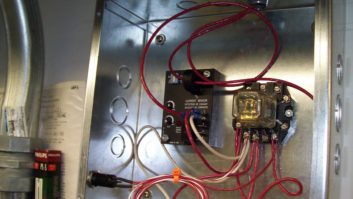FM IBOC site preparation
Mar 1, 2005 12:00 PM, By John Battison, P.E., technical editor, RF
From time to time in every chief engineer’s life it becomes necessary to prepare for the installation of a new transmitter or the major modification of an existing transmitter. This can be a harrowing experience or an exciting and rewarding experience if properly handled. The most important thing is to have an organized, scheduled timetable.
To keep a project on task, a PERT chart can be used to show every step that has to be taken and the order in which these steps must occur. PERT stands for program evaluation review technique. Probably most engineers prepare a written checklist of the steps to be taken and the equipment to be installed and have their own system of following through. I have always liked a modified PERT chart because you can then see the interrelated actions, the due dates and the steps that have to be taken to ensure that all required activities come together at the correct point.
When implementing digital IBOC transmission the most important decision to be made, apart from where to locate the transmitter, is which method of IBOC FM transmission will be used. Today we have a choice of four basic methods: high-level combining, low level combining, mixed level combining and split antennas in various configurations. Antenna space and tower load capacity will have considerable effect on the final decision.
A fresh start
If a new transmitter facility is to be constructed the transmission system decision is fairly easy to make between split-level, high level and low-level combining. Multiple antenna operation should be avoided, especially in new systems unless there is some strong reason for using it.
As IBOC developed, low-level and high-level combining of the two signals kept pace with the systems development. High-level combining is a somewhat wasteful process in which as much as 90 percent of one signal is dissipated in heat. Therefore, it seemed that it would be more efficient to combine the signals at a low level. Unfortunately, like many options encountered in radio engineering there is a downside to the system. Its broadband antenna, less efficient linear amplifier and power limitation tend to restrict its usefulness.
Recently, Harris and Cox Orlando engineer Steve Fluker suggested and developed split-level combining. This appears to offer considerable improvement in efficiency and in many cases less transmitter room floor space is required because transmitter cabinets may be smaller. However, when deciding between these three systems of transmission prepare a kilowatt-per-cost comparison of the three systems, and make sure to include all the minor incidentals involved.
Seeing double

Figure 1. Following a logical progression of steps can simplify the IBOC installation. Each task should have a defined completion date. Click here to enlarge this image.
Using two antennas (multiple antenna operation)–one for the analog and one for the digital signal–is a possibility, but it calls for additional antennas and transmission lines and extra space and loading capability for towers. What might be called a double antenna obviates the need for two antennas, but this system calls for more tower space and load handling capability for the tower and there is the possibility of reception problems due to the varying radiation fields of the two signals producing possible distortion and fading.
Space is also a pertinent consideration in the transmitter room because depending on the IBOC transmission system chosen space has to be allocated for the necessary combiners as well as the transmitter and ancillary equipment.
If the studio and production facilities are not colocated with the transmitter building, an STL will need to cover the distance. A path survey between the sites, STL frequency allocation coordination and application and additional equipment will help determine the best choice. Remember that new audio techniques and changed STL equipment requirements and older STL equipment may no longer be the best choice for digital transmission.
The digital nature of IBOC may allow shortcomings in the audio path to become noticeable. Also, depending on the station’s engineering plan, separate analog and digital audio paths and a data path may be needed.
Another important consideration in transmitter site selection is the availability of suitable ac power. This means that not only will the local power company provide power at a reasonable charge but it will also be clean power. When considering the primary power supply, ascertain the quality in terms of harmonics and power fluctuations of the proposed source as well as the frequency of occurrence of lightning strikes and voltage surges.
If an existing site is to be used together with some existing buildings the obvious requirements of suitable space, HVAC and acoustic adequacy must be carefully examined. Sometimes a proposed building is pleasing aesthetically and the temptation is to select it without considering all the pros and cons.
Time to look up
If the height matches the requirements of your CP, the major question then becomes is the tower capable of supporting the antenna(s) for your new station? Be sure that the tower as it stands, or as adequately and safely modified, can support the antenna and transmission line installation required for this project. This antenna survey must be performed by a qualified professional structural engineer. If an STL is to be used then the STL antenna and transmission line loading must be included in these calculations.
New construction that includes studio and transmitter installations for a new FM IBOC station will naturally follow AES standards and audio cabling designed for digital transmission. The usual precautions should be taken to ensure that no audio problems will arise through impaired digital signal flow caused by incorrect digital cable selection and installation.
E-mail Battison at[email protected].









